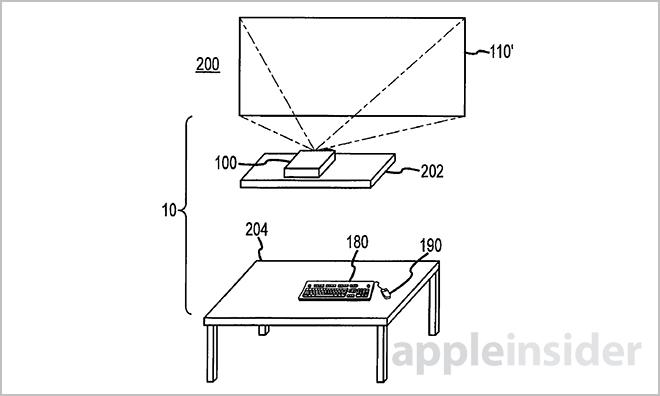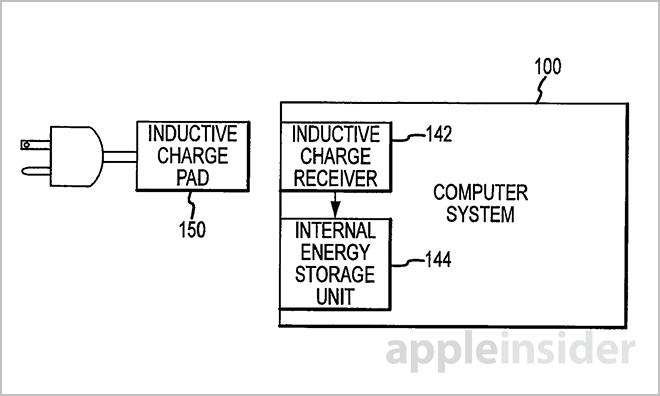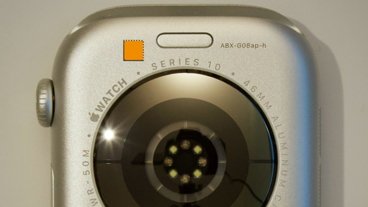The U.S. Patent and Trademark Office on Tuesday awarded Apple a patent for a completely wireless portable computer that uses a projection system, rather than a conventional LCD display, as its primary mode of visual output.
Apple's U.S. Patent No. 8,610,726 for "Computer systems and methods with projected display" imagines a portable computing system devoid of built-in display, keyboard and nearly all peripheral wires. Instead of the normal laptop trimmings, the box would be featureless, save for the LED or laser light projection system and speakers. The invention even calls for inductive charging to do away with unsightly power cords.
Basically, Apple's patent describes a computer housing with advanced smart projection technology. The device is not merely a projector, however, as the document clearly points out functionality would be equal to or greater than existing laptops and desktops. Further, with the integrated projection system, the device may be carried and mounted in a variety of spaces, while freeing users from fixed screen sizes.
The patent dubs the device a "desk-free computer," as its form factor is neither a laptop nor a desktop, but something else entirely. The document notes that the invention is not to be confused with so-called "smart projectors," which are limited in their image processing and color correction capabilities.
From top left: front, rear, top and side views of Apple's "desk-free computer."Unlike traditional projectors, the desk-free computer would be able to process raw image data from a DVD or other digital medium. Conventional projectors receive processed data as a specific video protocol and at a predefined resolution output, both of which are determined by a DVD player or other multimedia component. Apple's system is able to read data in the "raw space," or pixel-level output prior to rasterization or other preprocessing.
Unlike static projection setups, the desk-free computer is able to dynamically change its image settings based on sensor data, like that from an on-board camera. Other sensors include an accelerometer, ambient light sensor and depth sensor. Together, these components collect data regarding a display surface's color, texture and other features to dynamically produce an optimized image.
Image tweaks would be "lossless" in that pixel densities may be dynamically adjusted for keystoning, or the compensation of an image shape to be presented as a right square or rectangle if the projector is set at an angle. Also, the computer's user interface may be changed based on its distance from a display surface, which is some embodiments throws a 40-inch image from less than 15 inches away.
In addition to an integrated projector, the desk-free computer would also be substantially or entirely wire-free, with peripherals like a keyboard and mouse connected wirelessly. Further, power may also be transmitted via inductive charging, or through integrated batteries.
The future of Apple's invention is uncertain, though the technology exists to implement many of the features described above. While the form factor may be impractical compared to modern devices like the iPad and MacBook Air, projectors are still popular with some users and parts of Apple's patent may indeed be incorporated into a consumer product.
Apple's desk-free computer patent was first filed for in 2008 and credits Aleksandar Pance, Reese T. Cutler, Aaron Leiba, David Robbins Falkenburg, Jason Hau-Ping Chen, Alex Crumlin and Ken McAlpine as its inventors.
 Mikey Campbell
Mikey Campbell





-xl-m.jpg)


-m.jpg)






 Chip Loder
Chip Loder
 Thomas Sibilly
Thomas Sibilly
 Wesley Hilliard
Wesley Hilliard
 Christine McKee
Christine McKee
 Amber Neely
Amber Neely
 William Gallagher
William Gallagher
 Malcolm Owen
Malcolm Owen









33 Comments
I call prior art¡ [I][TURN SOUND OFF!][/I] [VIDEO]http://www.youtube.com/watch?v=5zhEuFwoVns[/VIDEO]
Wireless charging is a great invention. My desks at home and at work are cluttered with USB cables for charging devices.
I call prior art¡
[TURN SOUND OFF!]
An animated video of a 3D model is not Prior Art.
I said 2 years ago that this method would be the AppleTV product that brings it out of the hobby stage if they could get it bright enough. It bypasses flat screen TV manufacturing, which would bring no profits to Apple, and cheaply allows almost any size screen to fit any room in one product.
This is the difference from all other TVs out there, while going back to the future for projection TV. I still believe that Apple (and even third parties) will offer something to project on - a screen if you will.